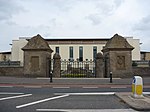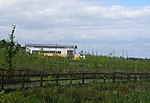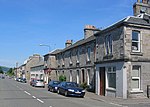Glencorse is a parish of Midlothian, Scotland, lying 7 miles (11 kilometres) south of Edinburgh. It is bounded on the north-west by the former parish of Colinton now within the City of Edinburgh, to the north and west by Lasswade and to the south and west by Penicuik.
The parish is in the northern part of the Penicuik and District Community Council area and includes the village of Auchendinny near its eastern boundary.The parish is traversed from west to east by Glencorse Burn, part of whose valley contains Glencorse Reservoir, which was formed in 1819-28 by damming the burn's glen with a huge embankment 40 m (130 ft) high. The reservoir is a source of Edinburgh's water supply. Also in the parish are Glencorse Barracks, Bush House, Glencorse House, Woodhouselee and Easter Howgate. The northern part of the parish includes some of the Pentland Hills and the highest point within the parish is Turnhouse Hill (428 m or 1,403 ft).Historical records of the Parish before 1878 spell it in various different ways - Glencors, Glencrosss, Glencrosse and Glencorse. After 1878 the last was normally used. There are several theories about the origin of the name Glencorse. One is that it comes form the Gaelic gleann - a glen and grosg or craig, a crossing - so a glen crossing the Pentland hills. George Chalmers in his book "Caledonia" claims the name comes from "a very remarkable cross, which has been erected in the vale of Glencross by pious hands." Yet another theory is that the name comes from a miraculous cross that appeared above Carnethy hill and encouraged the Scottish soldiers to defeat the English forces at the Battle of Roslin in 1303.The parish is divided between two Scottish Parliamentary constituencies: Midlothian North and Musselburgh to the north of Glencorse burn and Midlothian South, Tweeddale and Lauderdale south of the burn.





